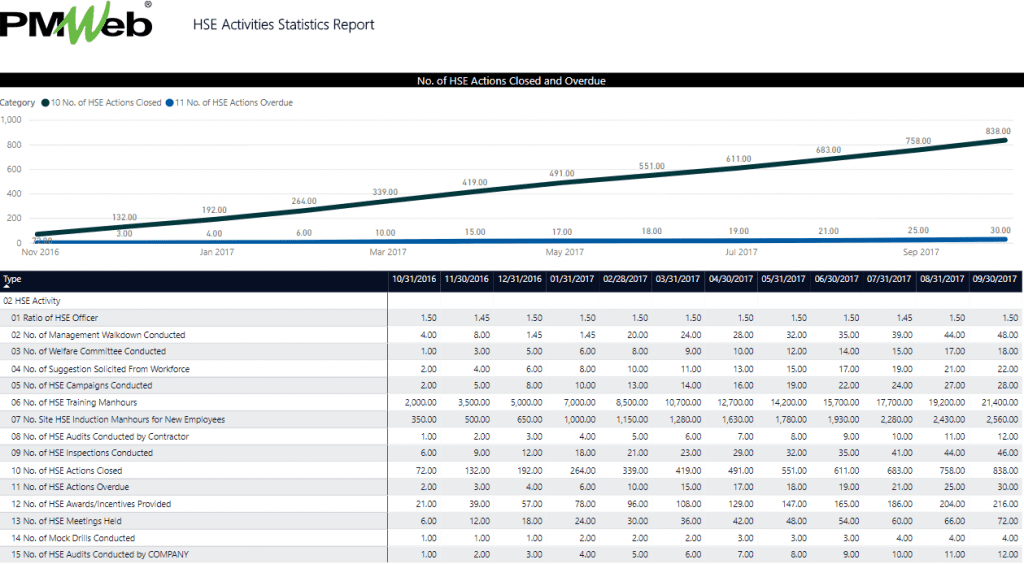The achievement of an organization’s Health, Safety, and Environment (HSE) strategy depend on capturing the right metrics so they can use those metrics to improve their HSE operations. One of the very common metrics used on construction projects is the lost time injury frequency rate (LTIFR). LTIFR gives the organization an objective insight into the safety performance of each project as well as the organization overall.
LTIFR is the number of lost-time injuries (LTI) occurring in a workplace per 1 million hours worked within a given period. A lost-time injury (LTI) is something that results in a fatality, permanent disability, or time lost from work. It could be as little as one day or shift. An LTIFR of 7, for example, shows that 7 lost time injuries occur on a job site every million hours worked.
Both lost time injuries (LTI) and lost time injury frequency rate (LTIFR) are considered lagging indicators of safety, meaning they provide insight into an organization’s past safety performance but are not necessarily indicative of its future safety performance.
Using a project management information system (PMIS) like PMWeb provides the organization with an accurate real-time measure for both LTI and LTIFR. PMWeb daily report module helps capture and calculate the total number of labor resource manhours spent on the project. This ensures that the resource man-hours used to calculate the LTI and LTIFR is accurate and auditable.

In addition, PMWeb comes ready with its own default safety incident module which captures all details of each safety incident including incident date, time, subject, location, types of safety incidents including those due to unsafe acts or conditions, motor vehicle, loss of containment, non-work-related fatality, near misses and other damaging incidents. In addition, each safety incident includes the type of causes that resulted in the incident. Those for example could include, slip and fall, structure failure, trench collapse, scaffolding accidents, run-over by operating equipment, roof-related fall, unsafe/faulty ladder, and welding accident among many others.
In addition, the PMWeb default safety incident form includes fields for the description of the work activity in progress at the time of the accident, description of the incident, people involved in the incident including their injury type, injured body part, injury severity, and lost working hours due to the incident. The safety incident form also includes a section to detail the causes of the safety incident and the witnesses for the incident.

PMWeb allows attaching all pictures, videos, police reports, civil defense reports, medical reports, and other documents associated with the reported safety incident. All those documents upload and store in the PMWeb document management repository.

To formalize the submission, review, and approval of the safety incident form, a workflow can be predefined to map the roles and responsibilities involved in managing the safety incident process. The workflow can include conditions to ensure that that safety incident is shared by the authorized project team members depending on the safety incident type.

To ensure the formal communication of the safety incident report, the PMWeb report writer helps to design the safety incident form in the desired form and format. The form should display the different approvals needed for the safety incident form.

The number of lost time injuries (LTI) will be based on the safety incidents captured PMWeb where the total number of man-hours spent on the project per period will be captured from the PMWeb daily report module. Those two values become the basis for calculating the lost time injury frequency rate (LTIFR) at the end of each period. Some organizations might introduce other HSE metrics like the total recordable injury rate (TRIT) where the numbers of restricted work cases (RWC) and medical treatment cases (MTC) get added to the number of lost time injuries (LTI). The RWC is any work-related injury or illness that is not covered by LTI which results in a person being unfit for the full performance of the regular job within 24 hours after the moment on which the occupational injury was received or illness determined. The MTC is any work-related injury or illness that is neither covered by LTI or RWC but requires treatment by or under the specific order of a physician or could be considered as being in the province of a physician.

In addition, the organization could include additional measures to monitor, evaluate and report the different HSE process- related activities status at the end of each period of the project duration. Those include:
- the ratio of HSE officers to other project team members
- number of management walk downs conducted
- number of welfare committees conducted
- number of suggestions solicited from the workforce
- number of HSE campaigns conducted
- number of HSE training manhours
- number of site HSE induction manhours for new employees
- number of HSE audits conducted by the contractor
- number of HSE inspections conducted
- number of HSE actions closed
- number of HSE actions overdue
- number of HSE awards/incentives provided
- number of HSE meetings held
- number of mock drills conducted
- number of HSE audits conducted by the project owner.




